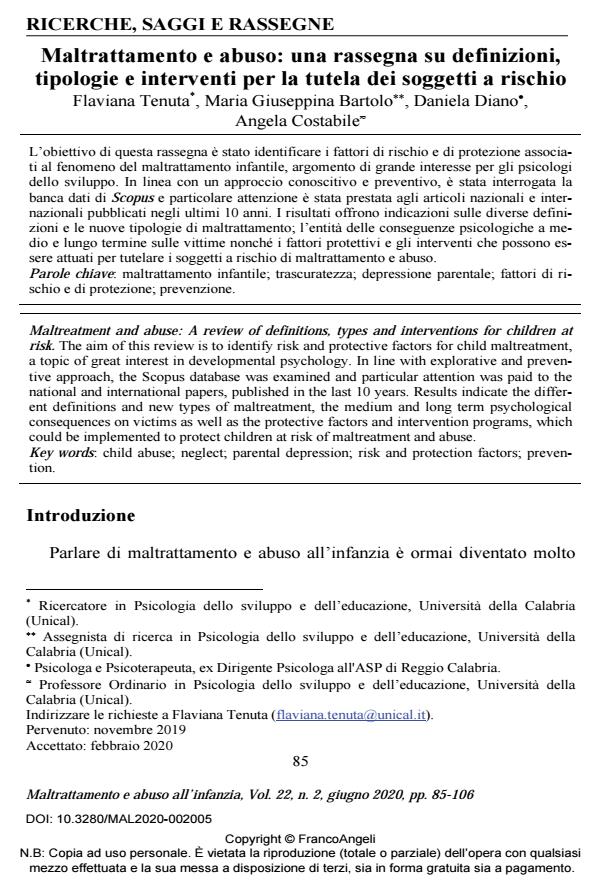Maltrattamento e abuso: una rassegna su definizioni, tipologie e interventi per la tutela dei soggetti a rischio
Titolo Rivista MALTRATTAMENTO E ABUSO ALL’INFANZIA
Autori/Curatori Flaviana Tenuta, Maria Giuseppina Bartolo, Daniela Diano, Angela Costabile
Anno di pubblicazione 2020 Fascicolo 2020/2
Lingua Italiano Numero pagine 22 P. 85-106 Dimensione file 253 KB
DOI 10.3280/MAL2020-002005
Il DOI è il codice a barre della proprietà intellettuale: per saperne di più
clicca qui
Qui sotto puoi vedere in anteprima la prima pagina di questo articolo.
Se questo articolo ti interessa, lo puoi acquistare (e scaricare in formato pdf) seguendo le facili indicazioni per acquistare il download credit. Acquista Download Credits per scaricare questo Articolo in formato PDF

FrancoAngeli è membro della Publishers International Linking Association, Inc (PILA)associazione indipendente e non profit per facilitare (attraverso i servizi tecnologici implementati da CrossRef.org) l’accesso degli studiosi ai contenuti digitali nelle pubblicazioni professionali e scientifiche
L’obiettivo di questa rassegna è stato identificare i fattori di rischio e di protezione associati al fenomeno del maltrattamento infantile, argomento di grande interesse per gli psicologi dello sviluppo. In linea con un approccio conoscitivo e preventivo, è stata interrogata la banca dati di Scopus e particolare attenzione è stata prestata agli articoli nazionali e internazionali pubblicati negli ultimi 10 anni. I risultati offrono indicazioni sulle diverse definizioni e le nuove tipologie di maltrattamento; l’entità delle conseguenze psicologiche a medio e lungo termine sulle vittime nonché i fattori protettivi e gli interventi che possono essere attuati per tutelare i soggetti a rischio di maltrattamento e abuso.
Parole chiave:Maltrattamento infantile; trascuratezza; depressione parentale; fattori di rischio e di protezione; prevenzione.
- Self-esteem and adolescent bullying/cyberbullying and victimization/cybervictimization behaviours: A person-oriented approach Anna L. Palermiti, Maria G. Bartolo, Pasquale Musso, Rocco Servidio, Angela Costabile, in Europe’s Journal of Psychology /2022 pp.249
DOI: 10.5964/ejop.5379 - Incidenza e caratteristiche dei minori accolti in Strutture Residenziali in Regione Lombardia Sarah Miragoli, Ciro Cascone, Francesca Sgrò, Vittoria Badino, Luca Milani, in MALTRATTAMENTO E ABUSO ALL'INFANZIA 3/2024 pp.67
DOI: 10.3280/MAL2023-003005 - Il progetto PEARLS for children in Italia, in Lituania e in Polonia Maura Brandoni, in MALTRATTAMENTO E ABUSO ALL'INFANZIA 1/2023 pp.19
DOI: 10.3280/MAL2023-001003 - TimMi: Ambulatorio per l'intercettazione delle fragilità familiari e la prevenzione del maltrattamento all'infanzia Lucia Romeo, Giusy Soldato, Valeria Brazzoduro, Monica Patrizio, Federica Giannotta, in MALTRATTAMENTO E ABUSO ALL'INFANZIA 1/2021 pp.89
DOI: 10.3280/MAL2021-001006 - Effects of maternal psychological distress and perception of COVID-19 on prenatal attachment in a large sample of Italian pregnant women Francesco Craig, Maria Cecilia Gioia, Vito Muggeo, Juanita Cajiao, Alessia Aloi, Iolanda Martino, Flaviana Tenuta, Antonio Cerasa, Angela Costabile, in Journal of Affective Disorders /2021 pp.665
DOI: 10.1016/j.jad.2021.08.102 - Fattori di rischio e di protezione nella valutazione di famiglie in carico ai Servizi Sociali: uno studio retrospettivo intergenerazionale Martina Cattani, in MALTRATTAMENTO E ABUSO ALL'INFANZIA 2/2022 pp.63
DOI: 10.3280/MAL2022-002005 - Nurse Home Visitation Program per la riduzione del rischio di maltrattamento infantile: una prima valutazione dell'intervento dell'Unità Funzionale Complessa Salute Mentale Infanzia e Adolescenza e Centri Consulenza Giovani dell'Azienda Usl Toscana Centro-Firenze Ludovica Di Paola, Annalaura Nocentini, Patricia Monica Bettini, Roberto Leonetti, in MALTRATTAMENTO E ABUSO ALL'INFANZIA 3/2021 pp.89
DOI: 10.3280/MAL2020-003008
Flaviana Tenuta, Maria Giuseppina Bartolo, Daniela Diano, Angela Costabile, Maltrattamento e abuso: una rassegna su definizioni, tipologie e interventi per la tutela dei soggetti a rischio in "MALTRATTAMENTO E ABUSO ALL’INFANZIA" 2/2020, pp 85-106, DOI: 10.3280/MAL2020-002005